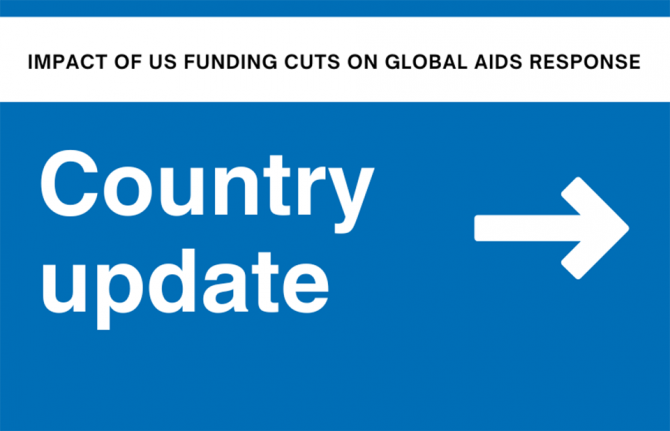unaids.org
UNAIDS




Feature Story
Impact of US funding cuts on HIV programmes in Lao PDR
14 avril 2025
14 avril 2025 14 avril 2025Immediate risks or disruptionsImpact on cooperative agreements:WHO-US CDC cooperative agreement: The...
Immediate risks or disruptions
- Impact on cooperative agreements:
- WHO-US CDC cooperative agreement: The WHO-US CDC cooperative agreement has been significantly impacted, particularly in provision of technical assistance to expand point-of-care services, expanding pre-exposure prophylaxis services, strengthening strategic information systems, capacity-building through training, workshops, and seminars, as well as travel and human resources-related costs.
- Ministry of Health cooperative agreement: The HIV department is partially impacted, with some planned activities not receiving full US Government approval or funding. The US funding cuts have significantly impacted maternal and child health programs, the original $400,000 commitment per year was reduced by more than 50%. This reduction has led to major challenges in capacity-building efforts, limited training opportunities for healthcare providers, and reduced plans for integrating maternal and child health services into point-of-care sites.
- WHO cooperative agreement: Fully affected, disrupting all planned activities under their Direct Financial Cooperation agreement with the government. This includes efforts to strengthen laboratory service quality, improve strategic data reporting and cover human resource- related costs.
- Service delivery:
- Routine HIV services at antiretroviral therapy sites and points of care remain largely unaffected due to the national programme’s continued provision of regular HIV testing and antiretroviral care.
- However, the US funding cuts have disrupted HIV prevention programmes, particularly those supported by PEPFAR through USAID/FHI 360 and WHO-US CDC. This has led to delays or disruptions in community-based HIV outreach programmes.
- Community impact:
- Eight staff members from the Association of People Living with HIV across 12 operational provinces will lose their jobs, further impacting service delivery and community support efforts.
- Community-led organizations have experienced a reduction or suspension of services, loss of funding, and loss of staff, reducing their ability to collect and report data and limiting their ability to reach out into the communities to provide HIV prevention services.
Politically relevant updates
- Government and international response:
- The Global Fund to Fight AIDS, Tubercuosis and Malaria (Global Fund) and the United Nations have advocated for the government to fully access and optimize the Health and Nutrition Services Access Project (HANSA) grant and loan components to bridge gaps created by the US funding cuts.
- Communities have approached the French funding mechanism L'Initiative from Expertise France to help close funding gaps.
- The UN Country Team has mapped the funding gaps and has started quantifying the reduction from the United Nations Sustainable Development Cooperation Framework (CF) as a result of the decrease in overseas development assistance. Eleven of the CF’s 21 outputs have been affected by funding reductions. Programmes affected by funding reductions account for more than a quarter of expected available funding in 2025. Outcome 1 (including Health, Nutrition and Food Security) has the most funding at risk of reduction. Outputs in Outcome 3 (Governance and Rule of Law) see the largest proportional reduction in funding.
- UNAIDS has supported the government in mapping the gap caused by the US funding cuts and has shared a report with the Global Fund and other development partners.
- UN Joint Team has mapped the impact on the Joint Programme. While the UNAIDS Cosponsors are looking for stop-gap measures to cover the gaps in the short term, the US funding cuts are expected to significantly reduce the UN’s contribution to the HIV response in Lao PDR. Since the US was the sole donor to UNODC’s health program in Lao PDR, this will result in the suspension of all UNODC health-related activities in the country as of May 1, 2025.
Civil society impact, resilience and response
- The Community-led monitoring for key populations project, implemented by the Association of People Living with HIV and supported by USAID/FHI 360, operates in Vientiane Capital, Savannakhet, and Champasak provinces. This initiative enhances community engagement among men who have sex with men and transgender individuals, strengthening their capacity to address their own health challenges while fostering trust and collaboration between communities and healthcare providers. This project has significantly improved health outcomes and reduced stigma. However, the suspension of this project is expected to hinder the expansion and scale-up of HIV community led monitoring across all key population services. The loss of eight staff members from the association of people living with HIV across 12 operational provinces will further impact service delivery and community support efforts.
- Despite these challenges, some community-led organizations are managing to sustain efforts through alternative sources of funding, demonstrating resilience and adaptability in the face of funding cuts. However, these measures may not be effective beyond 2025 and will result in weakening the inclusion of community-led efforts in the HIV response.
Related resources
Region/country
Related
 Impact of US funding cuts on HIV programmes in Malawi
Impact of US funding cuts on HIV programmes in Malawi

15 avril 2025
